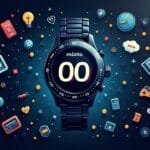Track Your Heart Rate and More: Top Wearable Fitness Tech Innovations Revolutionizing Everyday Life for Ultimate Wellness in 2025
Will Your Next Workout Be Controlled by AI? Discover the Wearable Fitness Tech Innovations Revolutionizing Sports in 2025 for achieving your best wearables sports fitness goals. From tracking heart rate and steps to personalized coaching, top innovations are transforming everyday life with ultimate wellness in mind.
The Rise of Wearable Fitness Technology
Wearable technology has been a staple in the fitness world for years, but recent advancements have taken it to the next level. Today’s wearables offer more than just tracking heart rate and steps; they provide personalized coaching, AI-driven insights, and seamless integration with other health apps.
The Top Wearable Fitness Innovations of 2025
- **Smartwatches**: Designed for both style and functionality, smartwatches offer a comprehensive fitness experience. They track heart rate, distance traveled, calories burned, and even provide AI-driven coaching to help you achieve your best wearables sports fitness goals.
- Fitness Trackers: Simple yet effective, fitness trackers are designed for those who want a hassle-free tracking experience. They monitor daily activity, sleep patterns, and can even track menstrual cycles for women.
- Wearable Fitness Bands: Thin and lightweight, wearable fitness bands offer a discreet way to track your progress. Some models even feature built-in GPS and water resistance, making them perfect for athletes who engage in aquatic sports.
The Impact of AI on Wearable Fitness Technology
Artificial intelligence has revolutionized the world of wearable fitness technology. By analyzing user data and behavior patterns, AI can provide personalized coaching, predicting goals, and even detecting potential health risks.
| Device | AI Features |
|---|---|
| Apple Watch Series 8 | Personalized coaching, AI-driven goal predictions, and advanced health monitoring. |
| Fitbit Ionic | Advanced heart rate monitoring, personalized coaching, and guided breathing sessions. |
| Garmin Forerunner 945 | AI-driven training plans, advanced analytics, and real-time performance tracking. |
The Benefits of Wearable Fitness Technology
Wearable fitness technology offers numerous benefits for individuals seeking to achieve their best wearables sports fitness goals. By providing real-time feedback and personalized coaching, these devices empower users to make informed decisions about their health and wellness.
- Improved Heart Health: Wearable devices can track heart rate variability, detecting potential issues before they become major concerns.
- Enhanced Performance: AI-driven coaching and personalized training plans help athletes optimize their performance and achieve their goals.
- Increased Mindfulness: Guided breathing sessions and stress tracking features promote mindfulness and overall well-being.
The Future of Wearable Fitness Technology
As wearable fitness technology continues to evolve, we can expect even more innovative features and devices in the future. From implantable devices to augmented reality experiences, the possibilities are endless.
- Implantable Devices: Future wearables may be implanted directly into the body, providing real-time monitoring and feedback without the need for external devices.
- Augmented Reality Experiences: Wearable technology will seamlessly integrate with AR experiences, allowing users to visualize their progress and goals in a more immersive environment.
Additional Sources of Information
The following sources provide valuable insights into the world of wearable fitness technology:
- Journal of Sports Sciences:** A leading publication for sports research, offering expert analysis on the latest trends and innovations in wearable technology.
- National Academy of Sports Medicine (NASM):** A reputable source for fitness professionals, providing evidence-based guidance on wearable technology and its applications.
- American Heart Association (AHA):** A trusted authority on heart health, offering expert advice on the benefits and limitations of wearable devices in monitoring cardiovascular activity.
Explore more in our category page or visit our homepage.



